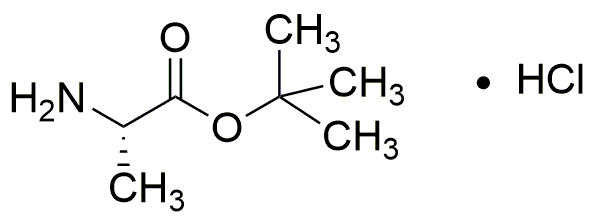L-Alanine tert-butyl ester hydrochloride is widely utilized in research focused on:
- Peptide Synthesis: This compound serves as a key building block in the synthesis of peptides, which are essential in drug development and biochemistry.
- Pharmaceutical Formulations: Its properties make it useful in formulating pharmaceuticals, enhancing solubility and stability of active ingredients.
- Biochemical Research: Researchers use it to study amino acid behavior and interactions, aiding in the understanding of metabolic pathways.
- Food Industry: It can be employed as a flavoring agent or additive, contributing to the enhancement of taste profiles in various products.
- Cosmetic Applications: The compound is also explored in cosmetic formulations for its potential benefits in skin health and hydration.
General Information
Properties
Safety and Regulations
Applications
L-Alanine tert-butyl ester hydrochloride is widely utilized in research focused on:
- Peptide Synthesis: This compound serves as a key building block in the synthesis of peptides, which are essential in drug development and biochemistry.
- Pharmaceutical Formulations: Its properties make it useful in formulating pharmaceuticals, enhancing solubility and stability of active ingredients.
- Biochemical Research: Researchers use it to study amino acid behavior and interactions, aiding in the understanding of metabolic pathways.
- Food Industry: It can be employed as a flavoring agent or additive, contributing to the enhancement of taste profiles in various products.
- Cosmetic Applications: The compound is also explored in cosmetic formulations for its potential benefits in skin health and hydration.
Documents
Safety Data Sheets (SDS)
The SDS provides comprehensive safety information on handling, storage, and disposal of the product.
Product Specification (PS)
The PS provides a comprehensive breakdown of the product’s properties, including chemical composition, physical state, purity, and storage requirements. It also details acceptable quality ranges and the product's intended applications.
Certificates of Analysis (COA)
Search for Certificates of Analysis (COA) by entering the products Lot Number. Lot and Batch Numbers can be found on a product’s label following the words ‘Lot’ or ‘Batch’.
Numéro de catalogue
Numéro de lot/série
Certificates Of Origin (COO)
This COO confirms the country where the product was manufactured, and also details the materials and components used in it and whether it is derived from natural, synthetic, or other specific sources. This certificate may be required for customs, trade, and regulatory compliance.
Numéro de catalogue
Numéro de lot/série
Safety Data Sheets (SDS)
The SDS provides comprehensive safety information on handling, storage, and disposal of the product.
DownloadProduct Specification (PS)
The PS provides a comprehensive breakdown of the product’s properties, including chemical composition, physical state, purity, and storage requirements. It also details acceptable quality ranges and the product's intended applications.
DownloadCertificates of Analysis (COA)
Search for Certificates of Analysis (COA) by entering the products Lot Number. Lot and Batch Numbers can be found on a product’s label following the words ‘Lot’ or ‘Batch’.
Numéro de catalogue
Numéro de lot/série
Certificates Of Origin (COO)
This COO confirms the country where the product was manufactured, and also details the materials and components used in it and whether it is derived from natural, synthetic, or other specific sources. This certificate may be required for customs, trade, and regulatory compliance.

